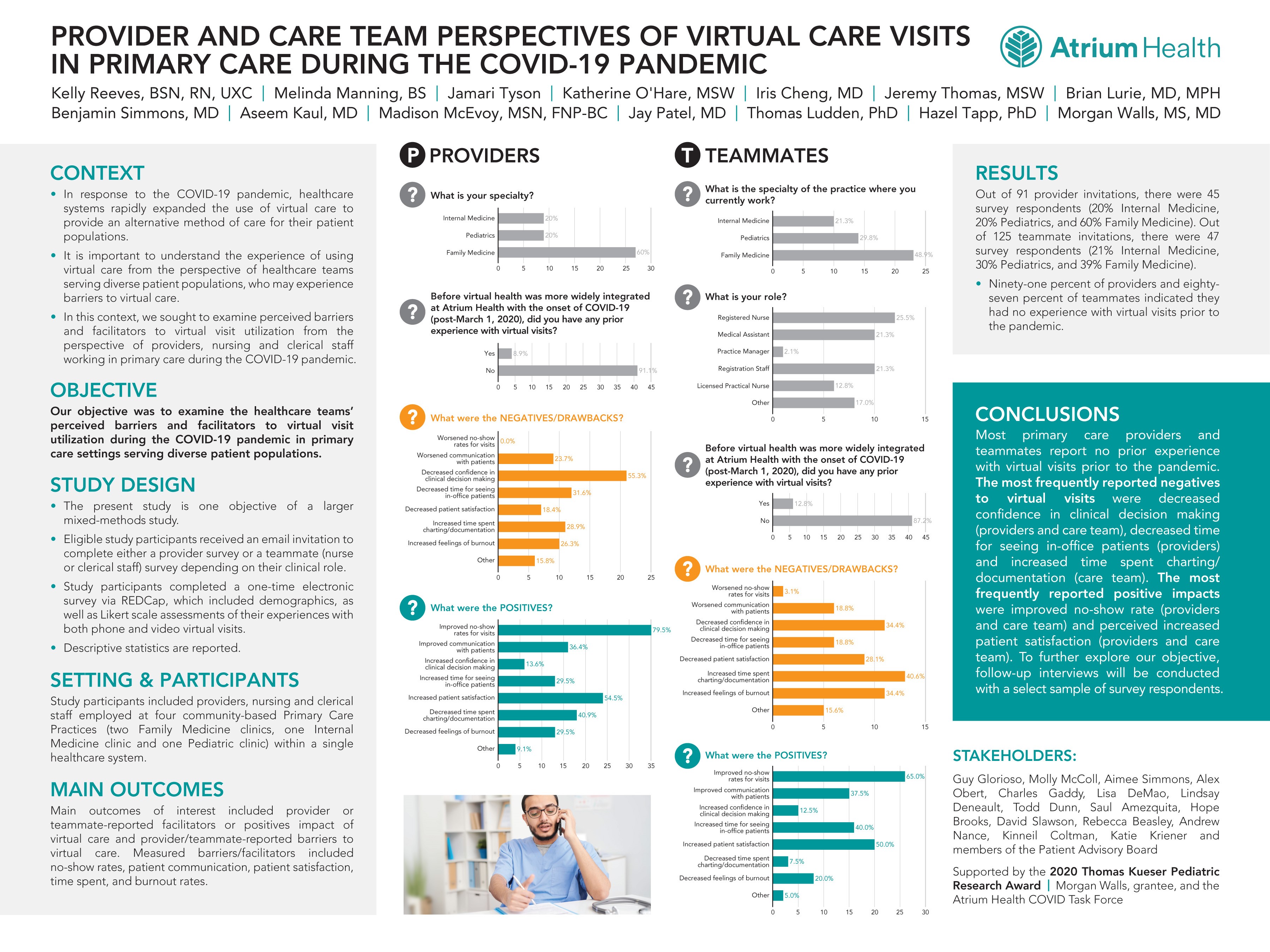PRP068: Provider and Care Team Perspectives of Virtual Care Visits in Primary Care during the COVID-19 Pandemic
Kelly Reeves, BSN, RN, UXC; Hazel Tapp, PhD, PhD; Iris Cheng; Jeremy Thomas, MSW; Brian Lurie; Aseem Kaul; Benjamin Simmons, MD; Katherine O'Hare, MSW; Madison McEvoy, BSN, FNP, MSN, RN; Melinda Manning, BS; Jamari Tyson; Morgan Walls, MD; Thomas Ludden, PhD
Abstract
Context: In response to the COVID-19 outbreak in the US, healthcare systems expanded the use of technology to provide virtual care to their patient population by virtual care solutions. However, certain patient populations may be more at-risk or vulnerable to experience barriers to virtual care. It is important to understand the experience using virtual care from the perspective of healthcare teams serving vulnerable populations. In this context, we sought to examine the healthcare teams’ perceived barriers and facilitators to virtual visits utilization during the COVID-19 pandemic.
Objective: In this context, our objective is to examine the healthcare teams’ perceived barriers and facilitators to virtual visits utilization during the COVID-19 pandemic.
Study Design: The present study is one objective of a larger mixed-methods study. For this objective, we conducted cross-sectional surveys with surveys emailed to eligible study participants. Surveys included demographic data, as well as Likert scale assessments of healthcare teams experiences with both phone and video virtual visits. Descriptive statistics are reported
Setting: Four community Primary Care Practices (Two Family Medicine, Internal Medicine and Pediatrics)
Patients or Other Participants: Providers and Care team (nurse, registration, staff)
Instrument and Data Source: Surveys and REDCap data base
Main Outcomes: 92 completed survey responses received to date. Ninety-one percent of providers and eighty-seven percent of teammates indicated they had no experience with virtual visits prior to the pandemic. The most frequently reported negatives to virtual visits were decreased confidence in clinical decision making (providers and care team), decreased time for seeing in-office patients (providers) and increased time spent charting/documentation (care team). The most frequently reported positive impacts were improved no-show rate (providers and care team) and perceived increased patient satisfaction (providers and care team).
Objective: In this context, our objective is to examine the healthcare teams’ perceived barriers and facilitators to virtual visits utilization during the COVID-19 pandemic.
Study Design: The present study is one objective of a larger mixed-methods study. For this objective, we conducted cross-sectional surveys with surveys emailed to eligible study participants. Surveys included demographic data, as well as Likert scale assessments of healthcare teams experiences with both phone and video virtual visits. Descriptive statistics are reported
Setting: Four community Primary Care Practices (Two Family Medicine, Internal Medicine and Pediatrics)
Patients or Other Participants: Providers and Care team (nurse, registration, staff)
Instrument and Data Source: Surveys and REDCap data base
Main Outcomes: 92 completed survey responses received to date. Ninety-one percent of providers and eighty-seven percent of teammates indicated they had no experience with virtual visits prior to the pandemic. The most frequently reported negatives to virtual visits were decreased confidence in clinical decision making (providers and care team), decreased time for seeing in-office patients (providers) and increased time spent charting/documentation (care team). The most frequently reported positive impacts were improved no-show rate (providers and care team) and perceived increased patient satisfaction (providers and care team).

hazel tapp
11/18/2021poster looks great!